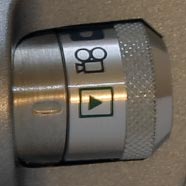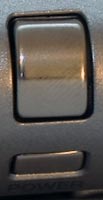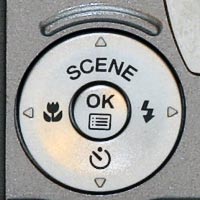Olympus Mju Mini Digital
(Olympus Stylus Verve in the USA)
Review Date: February 7th 2005
|
Ease of Use
The Olympus Mju Mini Digital easily wins the award for the most stylish and eye-catching digital camera that I have reviewed. Olympus have set out to make a camera that stands out from the crowd, and they should be applauded for providing some fresh ideas and innovation in the entry-level market where competition is fierce and profits per unit are small. The Mju Mini Digital will undoubtedly sell very well based just on its distinctive looks and diminutive size, plus the 6 iPod-like colours that Olympus has introduced. The Mju Mini is as much an attempt by Olympus to follow in Apple's footsteps and create something of a style icon, rather than simply cranking out another mundane digital camera.
So the Olympus Mju Mini Digital looks great, but what is it actually like to handle and use? Due to its small size and the distinctive rounded end, its actually a bit difficult to get a grip on (literally). My left hand kept getting in the way of the lens as it extended from the body when turning the camera on, and my right thumb naturally came to rest on the arrow pad, rather than near the zoom buttons. The rather large camera strap lug (in relation to the camera as a whole) near the arrow pad is large and obtrusive. I found that the best way to hold the camera was to use the tips of my fingers, but throughout the review period I never did get fully comfortable with the Mju Mini Digital from a handling point of view.
The Olympus Mju Mini Digital is a tiny digicam and will easily fit into a trouser pocket or handbag. Despite the front half of the body being made from aluminum, the Olympus Mju Mini Digital is a very light camera at just 115g without the battery fitted, which is good if you want a camera that is easy to carry around. The camera is generally very well-made, with the anodized finish on the front half seeming to resist scratches well. The rear is made from a grey plastic which is less impressive than the aluminum part, especially the battery compartment cover which feels very cheap in comparison. The zoom button and control dial are also made of the same plastic and don't quite match other aspects of the camera in terms of quality and feel.
| Mode Dial | Shutter Button / Power Button |
 |
 |
This strange mix of style and cost-cutting seems to run throughout the design of the Olympus Mju Mini Digital. The camera has a great sliding lens cover that rapidly moves to one side to allow the 2x optical zoom lens to emerge from within the camera body - perfect for impressing your friends and family. Less impressive is the plastic shutter button which has a spongy feel to it when you press to take the picture, as does the Power button and most of the principal external controls. The only really well made control is the barrel-like mode dial, which allows you to select the Play / Movie / Still camera modes. But why did the designers spend so much time and attention on one of the less-used controls? The large LCD screen on the back of the camera has a plastic cover that protects it from harm, but the Quick View isn't positioned centrally in the small hole in the cover. It's the lack of attention to details like this that means that Olympus have a long way to go before they match the likes of Apple.
At heart the Olympus Mju Mini Digital is quite a simple and straightforward digital camera, and subsequently there aren't too may external switches and buttons, just 7 in total. This makes it instantly accessible to its target market of first-time camera users. The menu system of the Olympus Mju Mini Digital is as well designed as previous Olympus digicams that I have reviewed. The four corners of the arrow pad act as directional buttons, allowing you to scroll through images and the menu system, but they also have their own specific functions as well. For example, the top button of the four allows you to select the scene modes, whilst the bottom one turns the self-timer on and off. This ensures that a lot of the controls are available by pressing buttons rather than scrolling through menus, which makes using the camera quicker and more immediate.
Pressing the OK button in the middle of the arrow pad accesses the rest of the menu options. These include setting the image quality, white balance, exposure compensation and a sub-menu called the Mode Menu, which contains settings like the metering mode and formatting the memory card. So the less commonly used options are accessed through the menu system, whilst the more commonly used options are available via the press of a button.
| Arrow Pad | Zoom Buttons / Microphone |
 |
 |
The start-up time of the Olympus Mju Mini Digital, from turning the camera on to being ready to take a photo, is quite quick at around 1/2 second. Despite only being a 2x zoom, the lens still takes a rather pedestrian 1 second to zoom from the widest focal length to the longest. The zooming mechanism is also quite noisy. Focusing is very quick in good light and the camera happily achieves focus indoors or in low-light situations. The LCD screen is rather grainy but the refresh refresh rate is perfectly acceptable. It takes about 0.25 seconds to store an image, allowing you to keep shooting as they are being recorded onto the memory card. In continuous mode the camera allows you to take 1 photo roughly every second. All in all the Olympus Mju Mini Digital is average in terms of operational speed.
Once you have captured a photo, the Olympus Mju Mini Digital has a good range of options for playing, reviewing and managing your images. You can scroll through the images that you have taken, view thumbnails, play a slideshow, zoom in and out up to a magnification of 4x, and view fairly detailed information about each image. You can also add an audio clip to each image, delete an image, rotate an image, lock images so that they cannot be deleted, and set various printing options. There are also a few digital effects available. The Edit menu contains 5 different options that you can apply to a recorded image - Soft Focus, Fisheye, Black and White, Sepia and Resize. The camera shows you a preview of what the effect will look like when applied, and importantly the effect is applied to a copy of your image, thus preserving the original intact. The most important missing feature is a histogram (both before taking a photo and after) which would be a great help in evaluating the exposure.
So the Olympus Mju Mini Digital is an extremely stylish digital camera that is relatively simple in terms of features and therefore quite easy to use. It does have some handling and build-quality issues, however, that spoil the overall design and concept of the camera.
|
 PhotographyBLOG is a member of the DIWA organisation. Our test results for the Olympus Mju Mini Digital have been submitted to DIWA for comparison with test results for different samples of the same camera model supplied by other DIWA member sites.
PhotographyBLOG is a member of the DIWA organisation. Our test results for the Olympus Mju Mini Digital have been submitted to DIWA for comparison with test results for different samples of the same camera model supplied by other DIWA member sites.
